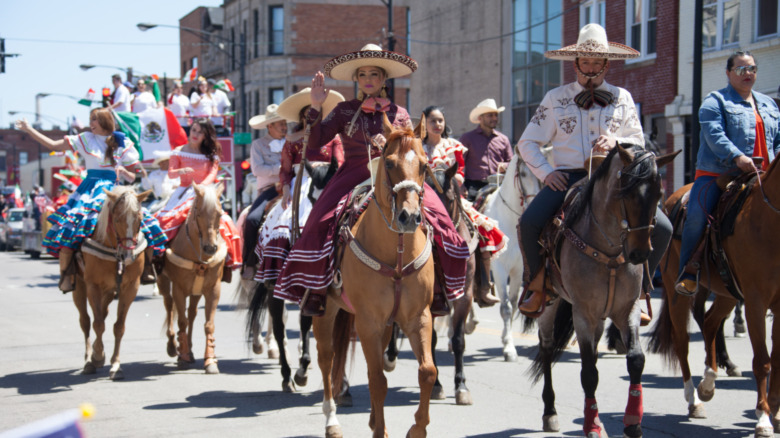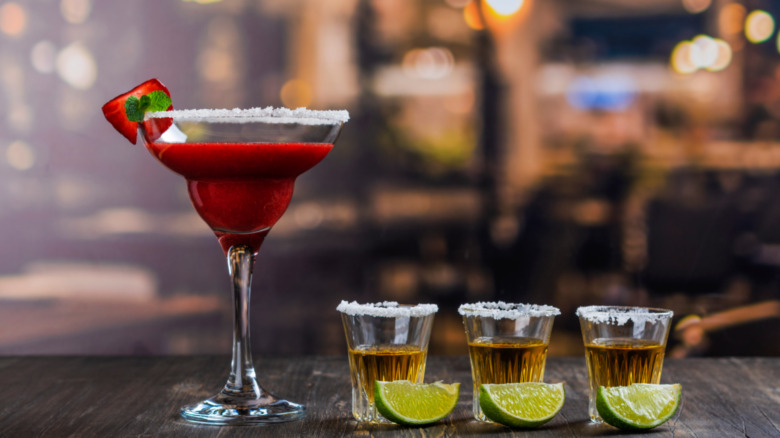The Biggest Myth You Should Stop Believing About Cinco De Mayo
Cinco de Mayo has followed essentially the same trajectory that all imported holidays do in the United States: It was brought over as a symbol of immigrant pride; non-Mexican Americans ignored it, then turned up their noses at it, and finally embraced it as an excuse to get drunk on a weekday, usually without learning anything about it. In fact, according to a survey conducted by Avocados from Mexico (because ... sure), only 22% of Americans have any idea what Cinco de Mayo is about — presumably about the same amount who have a clue who St. Patrick was (via the New York Post).
That's probably why it's never particularly hard to find a tequila-soaked frat boy stumbling down the street on May 5 yelling something about "Mexican Independence Day." Fortunately, those of us at Grunge are here to set you straight: 1: It's not Mexican Independence Day; 2: Mexicans already have an independence day (it's September 16, 1810); and 3: Please use a designated driver.
But let's take a look at what Cinco de Mayo is really about.
Cinco de Mayo commemorates the Battle of Puebla
About half a century after declaring its independence from Spain, Mexico found itself in dire financial straits and was forced to default on its debts to several European powers (via History). The end result of this was that the navies from three of them — Spain, France, and the U.K. — showed up in their harbors, demanding to know where their money was. Mexican president Benito Juarez managed to negotiate the Spanish and the British into leaving without starting a fight, but France invaded — mainly because Emperor Napoleon III (not that Napoleon — his much-less-impressive nephew) was looking to establish a North American empire, and Mexico seemed like an easy target.
Mexico was not prepared for a French invasion, and President Juarez and his government ended up having to flee the capital. French general Charles Latrille managed to march his men as far as the city of Puebla — which was where Mexican general Ignacio Zaragoza made his stand.
On May 5, 1862, Latrille attacked Puebla with an army of 6,000 men. Zaragoza and Juarez had nothing more than a ragtag band of 2,000 loyalists and dwindling supplies, but they managed to pull off a real underdog moment and sent the French packing. After a whole day of fighting, the Mexicans had lost only 100 men, while the French were retreating with 500 casualties.
Cinco de Mayo isn't even that big a deal in Mexico
While the Battle of Puebla victory was an enormous symbolic victory, it actually wasn't a particularly decisive one. Despite their loss at Puebla, the French eventually won the war (including a Second Battle of Puebla in 1863, which they won) and managed to turn Mexico into a French-friendly empire (via NPR). (The so-called Second Mexican Empire lasted only a few years, and was dismantled in 1867 with help from the U.S. — which had finally wrapped up its own civil war.)
That's probably a big part of why Cinco de Mayo isn't actually widely celebrated in Mexico — it's marked with parades and reenactments in Puebla, but it's virtually unknown in many other parts of the country (via Britannica). It's become a much bigger deal in the U.S., having been adopted by Chicano activists to promote Mexican-American pride in the 1960s. Still, it went mainly unacknowledged by the broader U.S. population until around the turn of the century, when tequila manufacturers and importers began using it to promote their products — proving once and for all that intoxication and greed are far more effective agents of change than activism or national pride.


